Redmi 15 vs Motorola Edge budget line: specs face-off

Comparing Xiaomi’s giant killer with Motorola’s sleek budget challenger
The Redmi 15 and Motorola Edge budget series aim to deliver big value in the affordable smartphone segment, but they take different paths to achieve it. While Xiaomi’s Redmi 15 focuses on size, battery, and display smoothness, Motorola’s Edge budget models lean toward better design, performance, and software polish.
The Redmi 15 boasts a massive 6.9-inch Full HD+ display with a 144Hz refresh rate, setting it apart in its class. It’s ideal for gamers and media lovers who enjoy extra screen space and silky-smooth visuals. In contrast, Motorola’s Edge budget line, such as the Edge 50 Fusion, offers a 6.7-inch OLED panel with a 120Hz refresh rate. Although smaller, Motorola’s screen delivers richer colours, deeper blacks, and better contrast.
Performance is another key difference. The Redmi 15 runs on Qualcomm’s Snapdragon 6s Gen 3 chipset paired with up to 8GB RAM, providing dependable power for daily use and casual gaming. Motorola’s Edge devices, like the 50 Fusion, use the more powerful Snapdragon 7s Gen 2, which handles multitasking and heavier games with greater stability. For users prioritising raw speed, Motorola holds a clear advantage.

Battery life is where the Redmi 15 takes the lead. Its massive 7000 mAh battery easily lasts up to two days on moderate use, while Motorola’s Edge series typically carries a smaller 5000 mAh cell. However, Motorola counters with faster charging—up to 68W on some models—compared to Redmi’s 33W support. So while Redmi lasts longer, Motorola recharges much quicker.
When it comes to cameras, both phones offer solid setups for their price. The Redmi 15 features a 50MP main sensor and an 8MP selfie camera, good for everyday shots but average in low light. Motorola steps ahead here with a 50MP main camera supported by a 13MP ultrawide lens and a sharper 32MP selfie shooter. For photography enthusiasts, the Edge has a more versatile and capable system.
Design and feel also differ noticeably. The Redmi 15 is large and sturdy, with a plastic frame and matte finish. It’s built for function more than finesse. The Motorola Edge, however, feels sleeker and more premium with its curved design, slim profile, and lighter weight, making it easier to handle despite its slightly smaller battery.
Software is another area where Motorola gets praise. Its near-stock Android experience feels smoother and cleaner compared to Redmi’s HyperOS, which includes more custom features and pre-installed apps. Motorola’s interface appeals to users who prefer simplicity, while Redmi’s offers extra control and customisation.
In pricing, Redmi aims at the value-conscious buyer, keeping costs lower while offering flagship-like display features and battery life. Motorola’s Edge budget line is pricier but justifies the difference with stronger performance, faster charging, and better design quality.
In summary, the Redmi 15 shines for users who prioritise screen size, endurance, and smooth performance at a low price. It’s perfect for entertainment-heavy use and long battery needs. The Motorola Edge budget models, on the other hand, are better suited for those who prefer power, premium design, and photography versatility. Both phones succeed in their own way — Redmi delivers the best endurance per pound, while Motorola brings a touch of flagship feel to the mid-range game.






